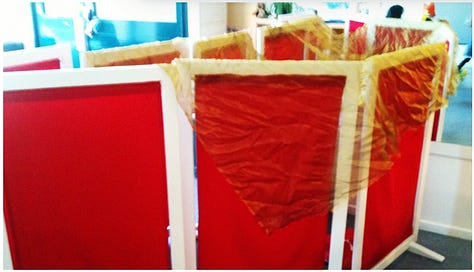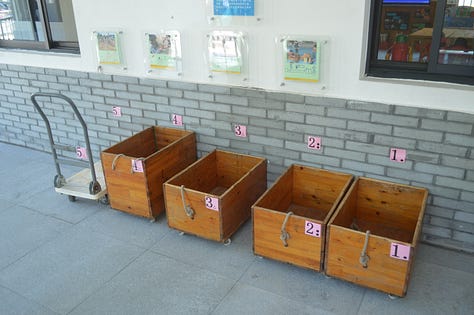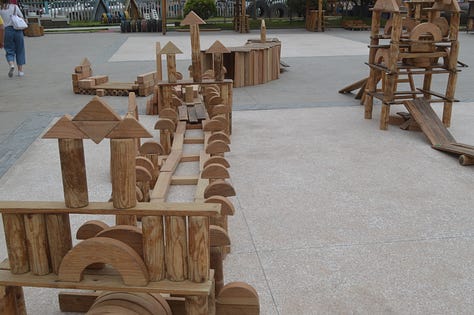The idea of “nomadic play” comes from the fat that play does not need a fixed physical space for it to happen... and neither does learning.
The word nomad means a member of a people that travels from place to place to find fresh pasture for their animals and has no permanent home where they stay year round.
What if we could use the word nomadic to create a reflective space to consider how children move from place to place to find fresh pasture (inspiration/possibility/space) for their play?
I have frequently seen how young children slowly (and sometimes speedier) transition from space to space with their play - sometimes it is the same play that evolves in different directions as it moves, other times the play is restarted, or a new play begins.
For this kind of play it can be important for children to
have permission to move things from one area to another
have adults who are aware when play in one area is put on pause to be returned to or when it has come to an end, and tidying up can be beneficial for the space to be opened up to new possibilities
have adults who are play literate and understand that if they move certain items into the periphery of the children they could inspire, or help the play continue.
have baskets, wagons, bags and other methods of transportation to ease not only the movement of things - but also to make the tidying up, when play is completed, more playful and easier, especially when a lot of stuff has been moved from one place to another
have space to park/pause their play - so that it can be continued later, the next day or over a period of extended time.
permission to not have to tidy up every time before moving on to something else
I think rigid thinking about how space can be used, the movement of stuff and tidying up can limit children's play. Sometimes I would much rather tidy up stuff to make space for the current play (mindful not to tidy away things that might be returned to) so that the flow is not disturbed - because the flow has so many benefits for the children as individuals and as a group.
When I have worked with toddlers I have seen a lot of this nomadic play - as they play with something until something else catches their eyes - like butterflies flitting around the room enjoying the nectar. What I like to do is to tidy up the mess they leave behind, mostly because one of the best play patterns a toddler likes is to dump everything out. So I figure if I put everything back in the baskets, boxes and shelves again then they get to play the play they love so much. In reality this is not so much tidying up as re-setting the play. it is hard to continue to play dumping everything out, if nothing is left in baskets and boxes.
Sometimes I notice things that have been arranged - those things I leave... they might be returned to, or they might inspire another child's play. But the stuff that looks like it's been dumped, I tidy. And yes, sometimes I make mistakes. But the more I observe children’s play, the less mistakes I make.
If we do not re-set the play for instance in the dumping example, the chances are the children will look for things to dump that they shouldn’t, and this creates frustration in the adults and the children. Observing the children’s play schemas can help us to re-set the play in a way that meets the children’s play needs and reduces frustration. It also allows children to enter a state of flow for a longer period of time, which is supporting their concentration focus.
I like to have things so that the children know where to find them. A kind of predictability that provides space for the children's creativity. So if they think of an idea they know where to get what they need to bring that idea into play. Play time can be wasted if they spend too much time looking for what they need to play. It’s just to think about how we get frustrated when shops switch things around and instead of knowing where to get the items we need quickly, we have to go looking for them.
This is why I like making tidy up time fun, and that I will always help the children tidy up. Too many times I have seen adults demand that the children tidy up and just watch them without any guidance (or maybe some orders) - and then get frustrated when things are in the wrong place... my experience of young children is that they like to tidy up fast (to get it over and done with) and things tend to get dumped in any old box and sometimes in the right one.
It's why I think of the play materials from start to finish.
Do we (the children and my colleagues) have the energy to take responsibility for all the materials available to play with? Sometimes less is more. I have found that some of the best play moments (where all the children are deeply engaged, all participating and clear signs of joy) have been with no stuff whatsoever - just the landscape (or roomscape) - children sat under tables, or running around outside or...
So having vast quantities of stuff is not essential to play.
This is not me saying not to have lots of stuff, or you should feel bad about having lots of stuff. If you have a group of children and adults that easily manage taking responsibility for lots of stuff then I say go for it. I think problems arise when the adults feel frustrated with the tidying up part because it’s creating a negative atmosphere about the things children play with and the way they play with them.
Sometimes over zealous tidying up can make the play frustrated... it keeps getting put away and not allowed to survive until the next time the children breathe life into it.
Another kind of nomadic play that I have seen is when a small group (sometimes large, but mostly 2-5 children) hang together talking, laughing and doing small play actions of various kinds, and then walk to another place and do something similar... a constant migration from place to place. I personally find something very soothing when I observe this kind of play. I think mostly because I remember three children who played like this every day for almost six months for at least a part of the day... chatting laughing, doing little movement - and sometimes suddenly run to a new place and start laughing and talking again, and then walk slowly to another place, then play for a short time on e.g the swings, to then return to their nomadic play.
For this kind of play there needs space and trust.
They often went into smaller hidden areas where they could divulge their secrets beyond the prying eyes and ears of the adults... I could hear them, but not the details. The energy was positive.. I seldom needed to intrude... occasionally when they came closer I would listen in... as evidence collecting to make sure my teaching was in line with their interests. Visibly invisible.
There is also that transient nomadic play when visiting a new place. Where the novelty of the space means the children have a hard time focusing on just one play... they need to explore, test, try out everything - what play possibilities are there.
Knowing this is important. It's impossible to demand settler play/learning when the children are in nomadic play/learning. For example if you visit a museum with the intent to learn something specific, many/some children will struggle to settle to that one topic as their nomadic drives are telling them they need to find out what is there, what possibilities, what will I miss if I settle for just this... it makes it hard to focus.
So I usually start with some time for the children to look around at everything if I must focus on one thing. If I am designing the museum visit - the first time would be just dedicated to exploration. It's why young children prefer to visit museums with their families... less other children's interests to compete with - they get to choose themselves how long to look at something and what next to look at...
Then there is the nomadic play where children collect stuff from one area and move it to another area. Quite often the reason is they are making a house, or a picnic or something else, but the actual play shifts and becomes the collecting of stuff and making of piles (sometimes these are very messy, because it is the dynamics of moving back and forth, selecting items, and carrying them back that is important and not the arranging). Sometimes this “play” I have been told is not “play” but work in order to play. So the same actions can be experienced very differently by the children.
I think it is sooo important that children get to engage in this kind of play - it often meets so many different schemas (transporting, positioning, enclosing, enveloping, etc), it can be done alone, or together with others (where all sorts of negotiations come into it - what is being collected, where are they going to be put, and how should they be arranged, and is it OK to take stuff from anywhere, what about other children using the materials etc etc etc), and of course there is the whole idea of rights and responsibility - if I have the right to move my play from here to there, I also have the responsibility to ensure that it doesn’t disturb the play of others, and that materials can be found again by others.









